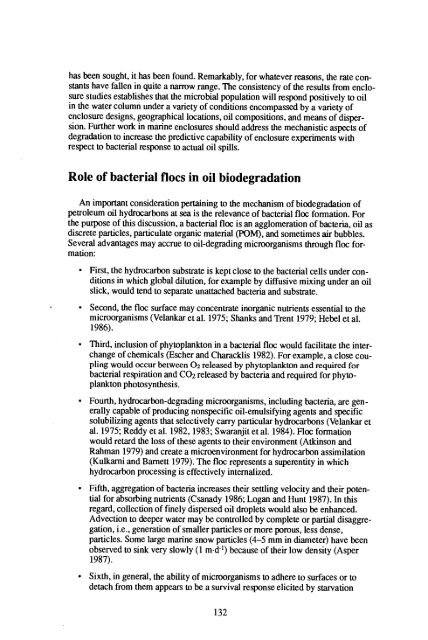Marine Ecosystem Enclosed Experiments - International ...
Marine Ecosystem Enclosed Experiments - International ...
Marine Ecosystem Enclosed Experiments - International ...
Create successful ePaper yourself
Turn your PDF publications into a flip-book with our unique Google optimized e-Paper software.
has been sought, it has been found. Remarkably, for whatever reasons, the rate constants<br />
have fallen in quite a narrow range. The consistency of the results from enclosure<br />
studies establishes that the microbial population will respond positively to oil<br />
in the water column under a variety of conditions encompassed by a variety of<br />
enclosure designs, geographical locations, oil compositions, and means of dispersion.<br />
Further work in marine enclosures should address the mechanistic aspects of<br />
degradation to increase the predictive capability of enclosure experiments with<br />
respect to bacterial response to actual oil spills.<br />
Role of bacterial flocs in oil biodegradation<br />
An important consideration pertaining to the mechanism of biodegradation of<br />
petroleum oil hydrocarbons at sea is the relevance of bacterial floc formation. For<br />
the purpose of this discussion, a bacterial floc is an agglomeration of bacteria, oil as<br />
discrete particles, particulate organic material (POM), and sometimes air bubbles.<br />
Several advantages may accrue to oil-degrading microorganisms through floc formation:<br />
First, the hydrocarbon substrate is kept close to the bacterial cells under conditions<br />
in which global dilution, for example by diffusive mixing under an oil<br />
slick, would tend to separate unattached bacteria and substrate.<br />
Second, the floc surface may concentrate inorganic nutrients essential to the<br />
microorganisms (Velankar et al. 1975; Shanks and Trent 1979; Hebel et al.<br />
1986).<br />
Third, inclusion of phytoplankton in a bacterial floc would facilitate the interchange<br />
of chemicals (Escher and Characklis 1982). For example, a close coupling<br />
would occur between 02 released by phytoplankton and required for<br />
bacterial respiration and C02 released by bacteria and required for phytoplankton<br />
photosynthesis.<br />
Fourth, hydrocarbon-degrading microorganisms, including bacteria, are generally<br />
capable of producing nonspecific oil-emulsifying agents and specific<br />
solubilizing agents that selectively carry particular hydrocarbons (Velankar et<br />
al. 1975; Reddy et al. 1982, 1983; Swaranjit et al. 1984). Floc formation<br />
would retard the loss of these agents to their environment (Atkinson and<br />
Rahman 1979) and create a microenvironment for hydrocarbon assimilation<br />
(Kulkarni and Barnett 1979). The floc represents a superentity in which<br />
hydrocarbon processing is effectively internalized.<br />
Fifth, aggregation of bacteria increases their settling velocity and their potential<br />
for absorbing nutrients (Csanady 1986; Logan and Hunt 1987). In this<br />
regard, collection of finely dispersed oil droplets would also be enhanced.<br />
Advection to deeper water may be controlled by complete or partial disaggregation,<br />
i.e., generation of smaller particles or more porous, less dense,<br />
particles. Some large marine snow particles (4-5 mm in diameter) have been<br />
observed to sink very slowly (1 because of their low density (Asper<br />
1987).<br />
Sixth, in general, the ability of microorganisms to adhere to surfaces or to<br />
detach from them appears to be a survival response elicited by starvation<br />
132
















